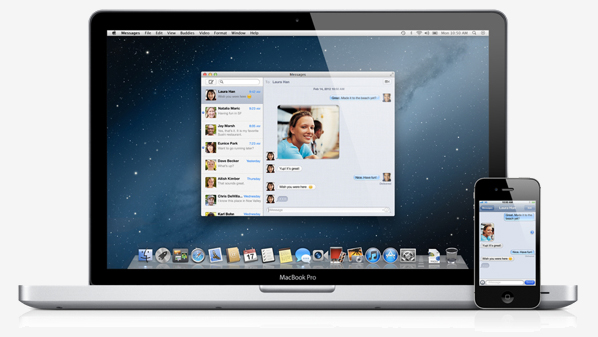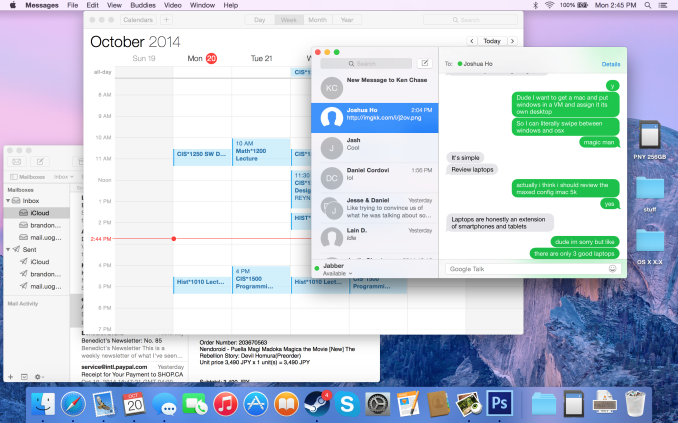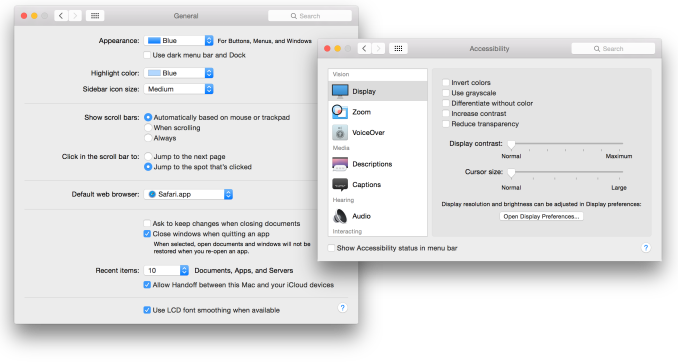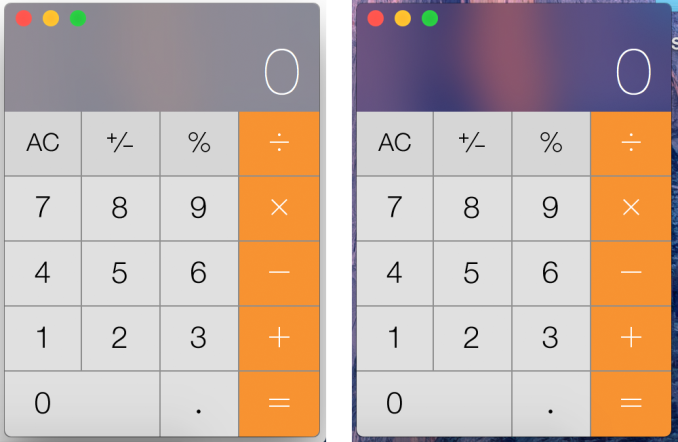A Look At OS X Yosemite And iOS 8.1
by Brandon Chester on October 27, 2014 8:00 AM ESTRethinking OS X
The original interface for iOS was inspired by Apple's Aqua UI, with skeuomorphic elements that mimicked real world objects. Computers have always mimicked the real world to a degree. They have buttons you press, and knobs you turn. The entire desktop metaphor is really just a digitization of the real world office with folders, documents, and a trash can. As computers have evolved and people have become more familiar with them, this overall metaphor has remained for the most part. But many of the visual elements that previously mimicked these real world objects could be simplified to copy in function, but not design. Users who are familiar with computers no longer need a distinct outline and heavy shading to recognize that a button is something they click or tap. They don't want their Calendar and Reminders applications to have leather borders, stitching, and paper like their calendar and date book in the real world, because doing so confines them to the limitations of those physical objects.
iOS 7 was in a sense a rebirth of iOS. The interface that had existed for six years was entirely redone. Core design elements like the homescreen remained, but everything was given a new visual style that eliminated skeuomorphism and ushered in a new era with a new design philosophy for Apple. This style of design is fairly well understood now. iOS makes heavy use of translucency and color. Each application has a primary color throughout which is indicated on its icon. Calendar uses red, Notes uses yellow, etc. With all these massive changes, the future of the design of OS X was uncertain.
One month after we got iOS 7, we got Mavericks. Mavericks was not the major overhaul that iOS 7 was. The visual elements of the operating system were very much the same as previous versions. This can simply be attributed to a lack of engineering resources. Apple's work to redesign iOS most certainly would have began after the departure of Scott Forstall which occurred after the release of iOS 6. Redesigning iOS in less than a year was quite an accomplishment, even with the bugs that were brought along with such a major change. It would have simply been impossible to do the same for OS X within the same period of time.
However, the design in Mavericks did not stand still. While the interface remained the same for the most part, many key applications that implemented skeuomorphic interfaces were redesigned. The leather and stitching was ripped out of apps like Calendar and Notes. The linen was removed from Notification Center and the login screen. These changes were the beginning of the path to what we have now with Yosemite.
For someone used to older versions of OS X, the above interface may seem like a shocking change. But for people who have been exposed to newer versions of iOS, it will actually feel quite familiar. The use of translucency, the flatter interface, and the new system font all draw upon the design principles that were established with iOS 7. It's important to understand what is meant by that. Apple is not establishing a common interface across their devices. OS X and iOS are not the same, and Apple has shown no interest in making them the same. What they are doing is using the same method of design, and the same type of interface elements, to create an experience across those two different operating systems that feels seamless and unified without having to compromise one to fit within the limitations of the other.
I was a fan of Apple's design direction with iOS 7, and so the same has held true for Yosemite. The use of translucency allows the customization of your wallpaper to have an impact on the appearance of the entire operating system. The status bar, the Dock, Launchpad, and any other window that uses translucency can look very different based on the wallpaper that is chosen. Using the new interface tends to have an interesting effect on the user by revealing how dated many parts of the older interface had become. Even users who enjoyed the older design will quickly find themselves questioning how they ever used such a dated interface. It's the same reaction I observed when the iOS userbase moved to iOS 7.
Usability and UI Performance
When the new design of Yosemite was revealed at WWDC 2014, some users voiced concerns that the new design would reduce clarity due to its lighter weighted fonts and heavy use of blur and transparency. On a typical 23" 1080p monitor I haven't noticed any issues reading text that uses the new system font which seems to be a modified Helvetica Neue, but I can see how it may be an issue on non-retina Macbooks where the viewing distance from the display is smaller than a desktop monitor. The blur is also well implemented to preserve legibility. Only the currently active window has the blur effects and transparency enabled. These sections turn opaque when a window is not being used, which means there are not layers upon layers of blur making it difficult to read any text on top of it.
For those who do find that some of the new design choices affect their ability to read or see things, Apple does provide a number of options for accessibility and visual customization. New additions include "Reduce transparency" which removes the translucency effects across the OS, and "Use dark menu bar and Dock" changes the white translucent material in the status bar, the Dock, and Spotlight Search to a black translucent material similar to Notification Center. I tried using the dark mode but I quickly reverted to the original design because the dark menu bar and Dock looked out of place amongst all the white and grey in the rest of the interface.
One issue I have observed with the blur is that windows will show the desktop wallpaper in addition to the applications between which should be blocking the wallpaper from showing through. As you can see above, despite me putting a completely opaque white box behind the calculator, there is still an area with an orange tint in the center. Removing the white reveals that the desktop has the same pattern. During the beta cycle the transparency would only display the wallpaper, and so there was a fix implemented but it introduced a problem of its own. I have seen complaints from other users about this issue, so hopefully it will be remedied in an upcoming update.
Performance is another area of concern with a new design and graphically demanding visual effects like translucency. I have noticed decreases in UI framerate compared to OS X Mavericks based on measurements with Quartz Debug. Overall the OS runs fairly well, but I would be lying if I said it didn't have its issues. Some scrolling lists will regularly drop to somewhere between 30 and 40fps. Scrolling performance in Notification Center is inconsistent, with performance closer to 60fps at some times, and closer to 30fps at others. The worst case I have encountered is the animation for Mission Control which has dropped as low as 5fps when many applications are open. Going forward it will be interesting to see how quickly and to what degree these issues are fixed by Apple.














173 Comments
View All Comments
SirPerro - Monday, October 27, 2014 - link
As a long term OSX power user and a long term Android power user I feel constantly dissapointed by OSX updates.I certainly understand Apple efforts to unify their experiences and make them consistent under the same ecosystem. That's good for their business.
Unfortunately I'm on a situation where OSX for me is more a handicap than something I'd like to pay for, and that's something which is reinforced on every single release.
I fear that after 13 years my current MacBook Pro from 2012 will be my last Apple product. I will not use a system which is focused to my grandma and obfuscates all the advanced features under complex bash commands in an effort to make them not available to the users. I will not buy a 2K laptop with soldered RAM and battery, let alone the stupid joke the new iMac is.
I'm sad, because OS X has been my main driver for some many years. But I'm not buying the Apple ecosystem, and apparently that's all that Apple wants to sell now.
tim851 - Monday, October 27, 2014 - link
What advanced features are obfuscated in 10.10 that weren't in 10.8?And what kind of power user is afraid of bash?
SirPerro - Monday, October 27, 2014 - link
Multi monitor is painful, and basically all the controls other than raising/lowering brightess/volume and activating trackpad gestures are taken as "advance" features and completely obfuscatedI'm not afraid of bash in any way. But there are many things that should have a UI purely for convenience. Apple doesn't build that because they treat their consumers as if they were idiots.
"It simply works" ... "and if not, just go find the solution in stackoverflow because we're not providing that info to you"
blackcrayon - Monday, October 27, 2014 - link
You're not going to disprove statements like "it simply works" by saying things like "multi monitor is painful". HOW exactly? As with Mavericks some people like it better if they turn off "Displays have separate spaces" in the Mission Control system preference. I personally like the new way better, so I'm wondering where the "pain" is.darwinosx - Monday, October 27, 2014 - link
You are "bashing" a product you clearly know nothing about so I really doubt you are an experienced user as pretty much everything you said is wrong. Try Windows or Linux. Bye.techconc - Tuesday, October 28, 2014 - link
When people make vague arguments and are not able to provide specifics, they come off as a troll. I'd like to think this isn't the case, but based on the comments provided, SirPerro is apparently just trolling. That's sad.If there is a specific issue, state your case and others will help you solve your problem. At this point, I doubt there is any such problem to speak of.
JimK85 - Saturday, November 1, 2014 - link
Here are some annoyances in OSX versus windows or Linux:1. Minimal Right-Click Context Menu. More clicking around to do things like simply creating a new folder
2. Wonky max/min window controls. Why cant I just maximize a window with "one" click
3. Far more extensive customization of task bars, toolbars in windows and linux versus the pretty dock and menus in OSX that are mostly "static".
4. Natively having the ability to rename multiple files with ease in windows is pretty handy.
5. Many apps in OSX cant do half screen windows...Why? In the windows/linux world any windowed app can be resized (this was a mistake Microsoft made with windows 8 which they are fixing in Win 10. )
I could go on but this isnt intended to be a bash OSX post. I'm sure we could list things about OSX that cant be done in windows or linux. I just find features I prefer are limited in OSX.
EnzoFX - Saturday, November 1, 2014 - link
1. Minimal? Apps can enhance right-click just as they do with Windows. Furthermore, what about shortcuts? I find OS X's shortcuts way more intuitive. I rarely use right-click because I can do most things with one click or a shortcut.2. Wonky? You clearly don't understand the intent of the "maximize" button, nevertheless if it's not for you, I can get that. But I wouldn't call it a con right away.
3. Uhm there are just as many apps that enhance the dock and menubar. I'd argue better ones over Win.
4. Renaming multiple files? Are you kidding me? OS X does this too you know.
I'm just gonna stop, you clearly haven't used the OS enough.
JimK85 - Sunday, November 2, 2014 - link
Some of these things are not native in OSX. You have to do it with a batch file or get an add on.osxandwindows - Wednesday, October 7, 2015 - link
I had all of this things sense OS X 10.6